Topical Tip: Handheld or simply supported photomicrography with suitable consumer digicams
by David Walker, UK
Ideally photomicrography should use a setup with a firm mechanical camera support, either on the microscope or supported independently. But some of the small lightweight consumer digicams are quite well suited for handheld use and with careful technique and good lighting, crisp enough imagery at low to medium mags are readily achievable. The sort of scenarios where handheld or simple mechanical supported photography may suit could be as follows:
- Microscopy away from base where a record photo is required but more rigorous camera setups aren't available.
- On a microscope that because of location and/or lack of photo head means handheld / simple support work for suitable images is preferred. This may apply for some monocular or binocular headed microscopes where the trinocular head doesn't exist or may be expensive or hard to source.
- Convenience! There may be a more rigorous approach available perhaps with other cameras but a quick shot over an eyepiece may be sufficient for its intended use. This can be the case with modern multi-megapixel cameras, where the full sized image may rarely be used. If the image is significantly resized e.g. for the web, even a not quite tack sharp image at full resolution may be perfectly acceptable when resized, especially when applying the sharpening often needed to ensure a large resized image doesn't look soft.
There are of course lighting setups where handheld work may prove impractical, especially if the lamp wattage is modest or if using e.g. polars, phase, strong oblique or darkfield. My own rule of thumb with a Sony P200 digicam is about a minimum exposure of ca. 1/20th second at 100ASA for sharp enough resized web images. On some digicams a little more leeway can be achieved by raising the ISO to 200, but image noise on small digicams can increase quite markedly above their native ISO, although recent camera reviews suggest some models are getting better in this respect.
Shared below are a selection of handheld images on microscopes the author has had access to, with comments on suitable techniques.
Suitable cameras: Digicam models with a lens barrel about same diameter as the typical 23 mm eyepiece may work well, especially if they have a modest optical zoom of ca 3x. The author's 7 Megapixel Sony P200 is shown (similar in features to the popular Sony W7), but Nikon, Canon, Fujifilm etc make similar models. Some are very good value nowadays.
It's worth experimenting with the camera features to see what works best for each subject. For naturally contrasty or well stained subjects with well defined edges, the camera's autofocus may work well, many have a focus lock indicator on the LCD preview to confirm it has focussed and where on the image. On the author's P200, setting Macro mode usually works better to autofocus. If the cameras has manual features, setting the camera to infinity and adjusting the microscope focus can be tried eg for poor contrast subjects. Although judging critical focus on the often small, low res' LCD may be tricky and for this sort of subject a table tripod work or other simple support to allow the hands to be free may be required. The digital zoom feature may help with critical focus and then dropping back into the optical zoom range to take the picture.
Some cameras may have a limited range of manual f stops (the P200 has f2.8 and f5.6 in manual mode), in which case if the camera isn't choosing the widest f stop in Auto, setting the widest f stop manually will give a higher shutter speed and may minimise any vignetting caused by the lens iris.
Suitable eyepieces: Ideally the digicam lens should be very close in diameter to that of eyepiece to permit a firm handheld technique and easy centering. Eyepieces with a flat front like some Leitz Periplans may be preferred to some of the Zeiss widefield designs (see photo below).
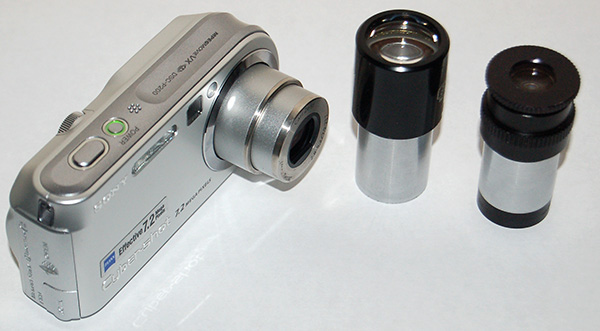
A Sony P200 digicam (7 Megapixel, 3X optical zoom) has a lens barrel diameter almost identical to the typical eyepieces for a ca. 23 mm compound microscope tube. The Leitz Periplan GF 10X/18 M eyepiece, right above, fills the maximum camera vignette field when camera touching eyepiece. The Zeiss Kpl-W 10x spectacle eyepiece, left above, has a higher eyepoint and requires a spacer (see below).
Monocular dissecting type microscope, 20x fixed mag or small student compound microscope: This is the sort of good basic microscope a family or school may start with for the youngsters. So investments in expensive dedicated supported cameras may not be justified. But competent handheld images can be obtained. The youngster could be trained to do this and hopefully be thrilled at being able to take their own images with a small digicam that may be available.
The minimum shutter speed for acceptable sharpness is likely to be related to the bulk of the microscope, so this design is the worst case of those shown for handheld work. However, because of the small size of the scope there may be plenty of desk space to support the camera on a small table tripod. The correct angle and height can be preset and the camera can be brought up to the microscope when required.
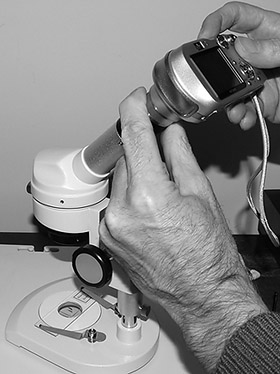
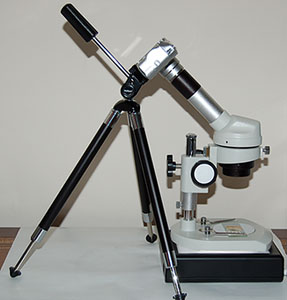
Left: A hand supported Sony P200 digicam on a typical 20x monocular microscope. The lens is almost the same diameter as the eyepiece so a thumb and forefinger grip can be effective to both center the camera and lightly support on the eyepiece. This technique is also more widely applicable, where the minimum shutter speed may be lower as the larger microscope offers something to brace against.
Right: The intensity of the incident and top lighting isn't likely to be high for this style of microscope, so a small tripod is preferable. Used here with a 35mm slide viewing box for transmitted light studies. A Micscape article on using this type of microscope, often recommended as the first microscope for a youngster, is here.
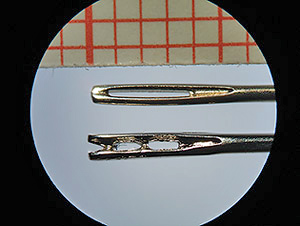
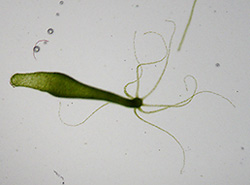
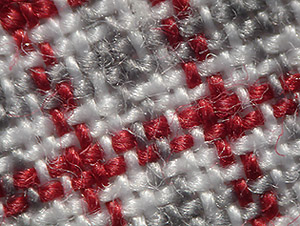
Left to right, images taken on table top tripod: Needles with 1 mm graph paper, live hydra and detail of handkerchief.
For handheld work the lens zoomed out to keep the shutter speed higher is preferred. Vignetting is likely but can be a quite suitable border for the right subject. Live subjects at low mag that aren't too active can be photographed. If supported on a tripod, zooming in (using the optical not the digital zoom) to fill the frame with subject is possible.
Larger microscopes without rubber eyecups: The same finger and thumb grip shown above may be suitable for larger microscopes if the eyepiece diameter is a close match to the lens diameter. Successful handheld work could depend on the eyepiece style and if the eyepiece is at a comfortable height. The author's microscopes' eyepieces are at about chest level on the desk when standing up, allowing the camera to be braced on the eyepiece as well as keeping the arms well into the body for a steadier technique.

Larger microscopes may allow a much better stance to be adopted for reducing image shake. A Sony P200 held here against the eyepiece of a Leitz microscope with arms braced against chest and one hand using the other eyepiece for extra support. With care sharp pictures with shutter speeds of 1/20th or lower may be possible (although in this case the trino' head would be first choice for photo' work!).
If a trino' port is available, as here, a vertical handheld technique can be tried. In this case I hold the Sony P200 lens to eyepiece with one hand and release shutter using the self timer.
Eyepieces with high eyepoints: For modest eyepoint eyepieces, the image may fill the field with the lens touching the eyepiece. For some high eyepoint eyepieces, the camera may need raising some millimetres off the eyepiece to evenly fill the field. In this case a suitable spacer could be made. When required the author uses the dense black foam used for re-lightproofing SLR cameras as it comes in a set of different thicknesses.
Eyepieces with rubber eyecups: The rubber eyecups on some narrower eyepieces may hold the camera lens very snugly, e.g. the eyepieces on the modern Leica BME student compound microscope. If not, the eyecups may be removable or could be folded down. Although an oversized eyecup, such as the 30 mm eyepieces on some stereos or modern compound microscopes, can be used to advantage by making spacers as shown below to accurately centre the camera in the eyecup, and improving the camera support for potentially steadier images to be taken.
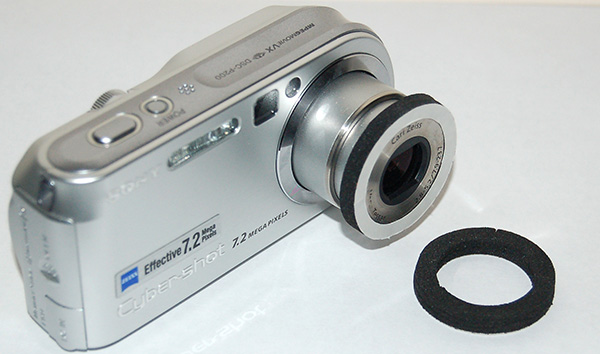
Sony P200 with two dense rubber foam spacers. The one on lens centres the camera in a wide rubber eyecup on a modern 30 mm Leica eyepiece. The other spacer is placed inside the eyecup to raise the lens to the correct eyepoint if required. A home crafts compass cutter can cut the spacers accurately.
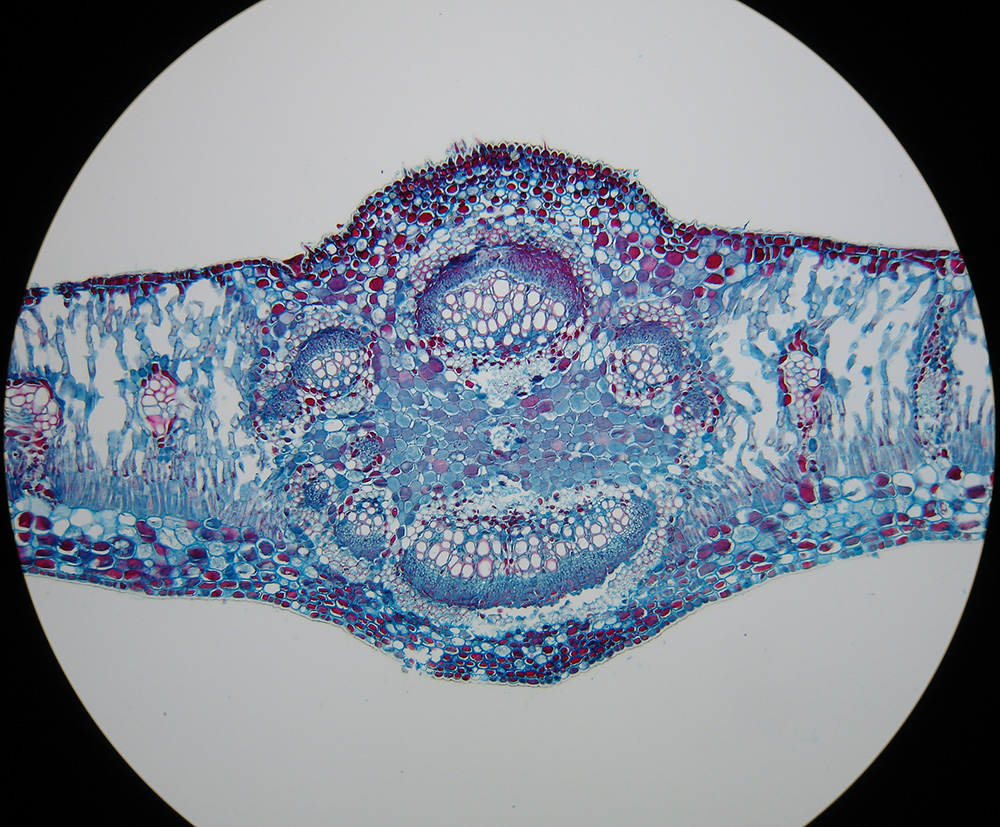
Sony P200 handheld in the snug rubber eyecup on a colleague's student Leica BME microscope. Although the lamp is only 30W at full intensity, with a 10x NA0.22 planachromatic objective a shutter speed of 1/500th at ISO100 was required, to minimise any residual camera shake. Biosil slide, sea grape stained leaf T/S. The lens can be optically zoomed in to remove vignetting but the camera may set a lower shutter speed. With multimegapixel cameras, a crop from the vignetted field can be made post capture.
The vignetting here is caused by the field stop of the eyepiece and don't find it objectionable as can easily crop, optically zoom in a little or retain as full field of view capture. Vignetting caused by an over stopped down iris is often soft edged and may be more severe; manually setting the camera iris, if it's a camera feature, to full aperture should minimise this.
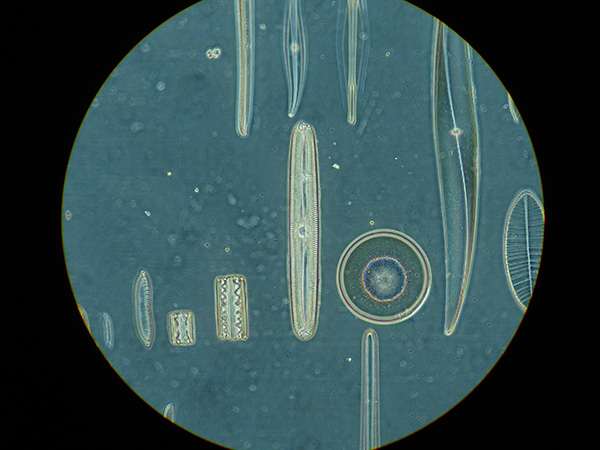

If the lamp is a high intensity one, handheld photomicrography using light demanding techniques such as phase up to medium mags may be possible with suitable subects.
Upper image, full camera image area, Leitz Diaplan 100W halogen lamp at full intensity, Leitz Periplan 10x eyepiece, with phase using Zeiss 45X NA0.75 Neofluar. Handheld Sony P200 on self timer, exposure 1/400th, f2.8, ISO100. In Auto mode, the camera tried to use its higher f5.6 stop, so changed to manual and set f2.8. Set -0.7 EV to correct for lighting of subject.
Lower image, crop of central diatom from same image, no post capture sharpening. The camera autofocussed on the central diatom in macro mode and gave a competent sharp image, even though in this instance it only filled a small area of field. Optically zooming in for the image to cover more pixels is desirable but the camera may need mechanical support if the shutter speeds drop significantly.
Slide - Klaus Kemp's 'Test plate 42 form', mountant Zrax.
Other simple adapters: The hobbyist may be able to devise other adapters from odds and ends to hand for these lightweight digicams, although care must be taken to ensure the camera doesn't shut down if any clamp is made to the lens as this may damage the lens motor. The excellent range of adapters supplied with the Moticam for example can securely clamp a Sony P200 to a compound or stereo microscope. See this Micscape article. Some camera suppliers also offer 'digiscoping' adaptors that screw into the camera tripod bush then clamp onto the eyepiece tube, e.g. see the SRB Griturn website.
For the more sophisticated consumer digicams with fixed lenses there are often adapters available for 'digiscoping' (i.e for microscopy, terrestial / astro telescope work). But the adapter cost may reach a point where another camera approach is more cost effective, e.g an in eyepiece microscope camera with relay lens or even a digital SLR which are steadily dropping in price.
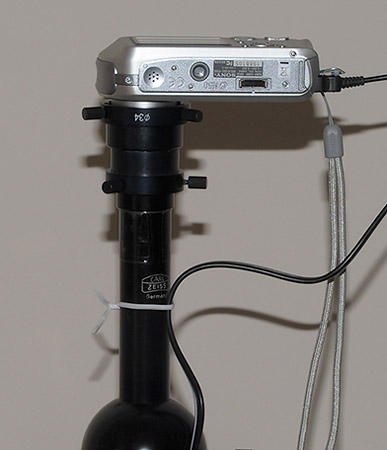
Sony P200 supported on a vertical phototube using two Moticam adapters glued back to back. The home engineer may be able to devise similar homemade adapters. The adapters have nylon tipped centering screws so don't damage the robust metal lens barrel. The camera is mains powered in this instance to stop the camera auto shutting down (3 minutes on battery for the P200) to avoid lens motor damage. Other pairs of the set can also clamp the camera to 30 mm eyepieces e.g. on a stereo microscope.
Although such photo setups can appear basic, with the right sort of well lit subjects, camera mechanically supported and with images taken at the camera's native ISO, these modern consumer digital cameras can be capable of exhibition / competition quality photomicrography. Dedicated microscope cameras with comparable megapixels can be far more expensive.
Comments to the author David Walker are welcomed.